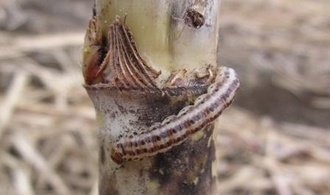Sugar cane: trapping the stemborers!
Written by Modified on the
Chilo sacchariphagus, better known as the stemborer, it is one of the most feared insect pests among cane growers in Réunion. An ecological way of controlling these pests has recently been discovered by a team from CIRAD in Réunion. The new technique works by attracting stemborers away from the sugar cane to “trap” plants (Erianthus arundinaceus), which to the stemborers appear identical to sugar cane. These trap plants will be spaced around the cane field. The trap plant acts as a sort of ‘decoy’ for females stemborers, who lay their eggs on its leaves, instead of on the sugar cane. However, the larvae fail to hatch and die on Erianthus, "trapped" inside the stem of the plant. This means fewer stemborer larvae and fewer attacks on sugar cane. In trials, the CIRAD observed a significant reduction in cane damage and a 22% increase in yield.
Trapping and repelling the stemborer
Given these promising results, which will soon be published in the Journal for Crop Protection, the CIRAD, in partnership with FDGDON, eRcane and agricultural schools*, has issued an appeal for innovation projects and a partnership with the Ministry of Agriculture. EcoCanne, which is based on the push-pull strategy developed by ICIPE (African Insect Science for Food and Health) in Kenya to fight against Striga and maize stemborers, has had a very positive response. The two main aims of EcoCanne are to investigate ways of reducing numbers of cane stemborers and to keep weeds under control.
The project will first address the practical issues related to the planting of borders around the cane field: what to do during harvesting, how to improve them, etc. It will also discuss the development of the "push" method of dealing with the stemborer, namely to find plants that repel the insects, as well as plants that attract and trap them. "In our first tests, we have shown the effectiveness of the "pull" (attraction) method through the use of Erianthus arundinaceus grass. We must now develop the "push" (repulsion) method: the idea is to implement legume cover, to repel stemborers while controlling weeds," says Samuel Nibouche, entomologist and project manager at the CIRAD.
Meanwhile, the "push-pull" technique will be combined with biological control releases of Trichogramma (oophages parasitoids) developed by INRA, CIRAD and FDGDON. In more general terms, technical solutions will be developed with agricultural colleges* and cane growers. Complete results will be published at the end of 2015.
*EPLEFPA St Paul and St Joseph
Life is hard for Weeds...
Finding alternatives for herbicides is one of the biggest challenges facing the sugarcane industry. Although EcoCanne will target weed management, its sister project, CanEcoH has been set up specifically to deal with sugar cane weeds. CanEcoH will be coordinated by eRcane and trials will be conducted both on experimental stations and on farms (as part of the MagecaR project) in partnership with the DEPHY Farms network and the Association Terre de Réunion. The target is a 50% reduction in the use of synthetic herbicides by using more effective crop management. Solutions include sowing legumes, mechanical weeding or double-spaced mowing, using cane mulch, rotations, self-seeding, row spacing, tillage infill, etc.


